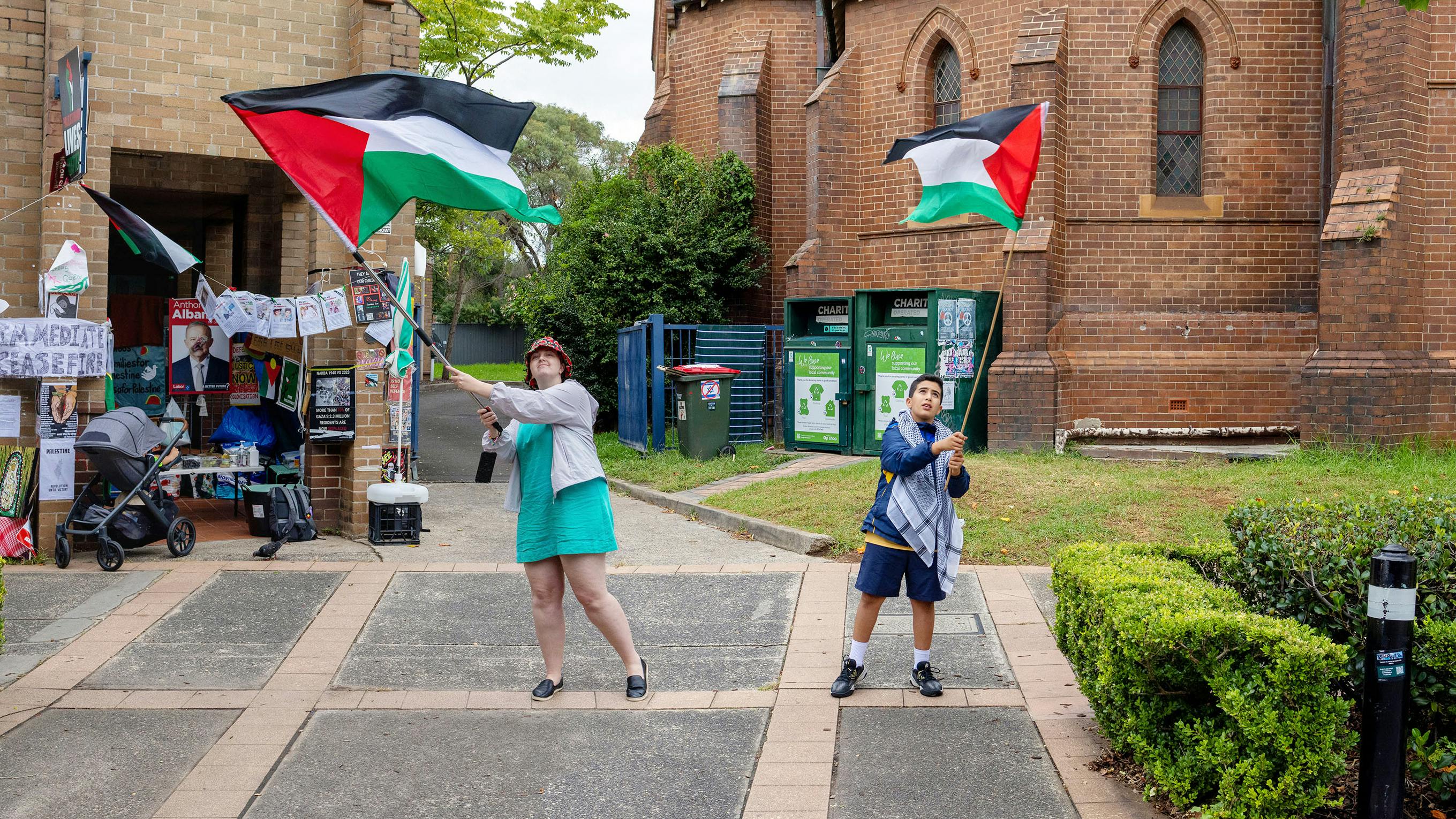
Can I Take Your Picture?
Cherine Fahd on photographing a picket
Since early 2024 Cherine Fahd has been photographing the picket outside the Prime Minister’s Marrickville office organised by Families for Palestine. Poised between craft and care, Fahd’s lens lays bare ‘the intimate poetics of political dissent’.
February 11, 2024.
familiesforpalestine
Urgent Call for Support! Members of Families for Palestine are camping outside Anthony Albanese’s office, starting tonight. Come for an hour, stay the night, or show your support by leaving a handwritten note on the gate. Your actions matter! Share this message and join us in demanding a ceasefire, restoration of UNWRA funding, and an end to supporting Israel. Repost and spread the word! 🕊️✊ #SupportForChange #CeasefireAction #FamiliesForPalestine #childrenofgaza #freepalestine #savegaza #ceasefirenow #permanentceasefirenow
The camera’s mechanics start with the press of a button. The shutter springs into action, and the gears and levers engage, quickly opening and closing the curtains to take the shot. A metallic whisper slides through the camera’s body. The sound is distinctive, a mechanical chorus marking the culmination of each photographic capture, echoing the intricate responsibility of a grieving photographer in quiet protest.
On Saturday, February 24, 2024, I arrive with my camera at Prime Minister Anthony Albanese’s local office in the Sydney suburb of Marrickville. My friend, a local resident, has suggested I take photos of the peaceful protest outside Albo’s office. Your actions matter!
I admit to being scared of protests. I tell my friend that a picket is outside my photographic expertise; I am not a documentary photographer. I also confess that I can’t stop crying at the Hyde Park rallies, and I have such overwhelming anger that I worry the picket will emotionally undo me. She reassures me it’s a quiet and peaceful protest.
Arriving at 334 Marrickville Road, I am greeted by a young man named Fadel. I introduce myself as Cherine, the photographer. ‘Where are you from?’ Fadel asks. ‘I’m Lebanese.’ ‘Me too!’ We instantly trust each other. I say that I want to take photographs of the sit-in. He asks if I can get a story into the media. I promise to pitch a piece for The Conversation, but I can’t promise it will get accepted. I ask more questions about the sit-in and whether anyone can join. He points to a bottle-green camping chair. ‘Yallah, sit.’
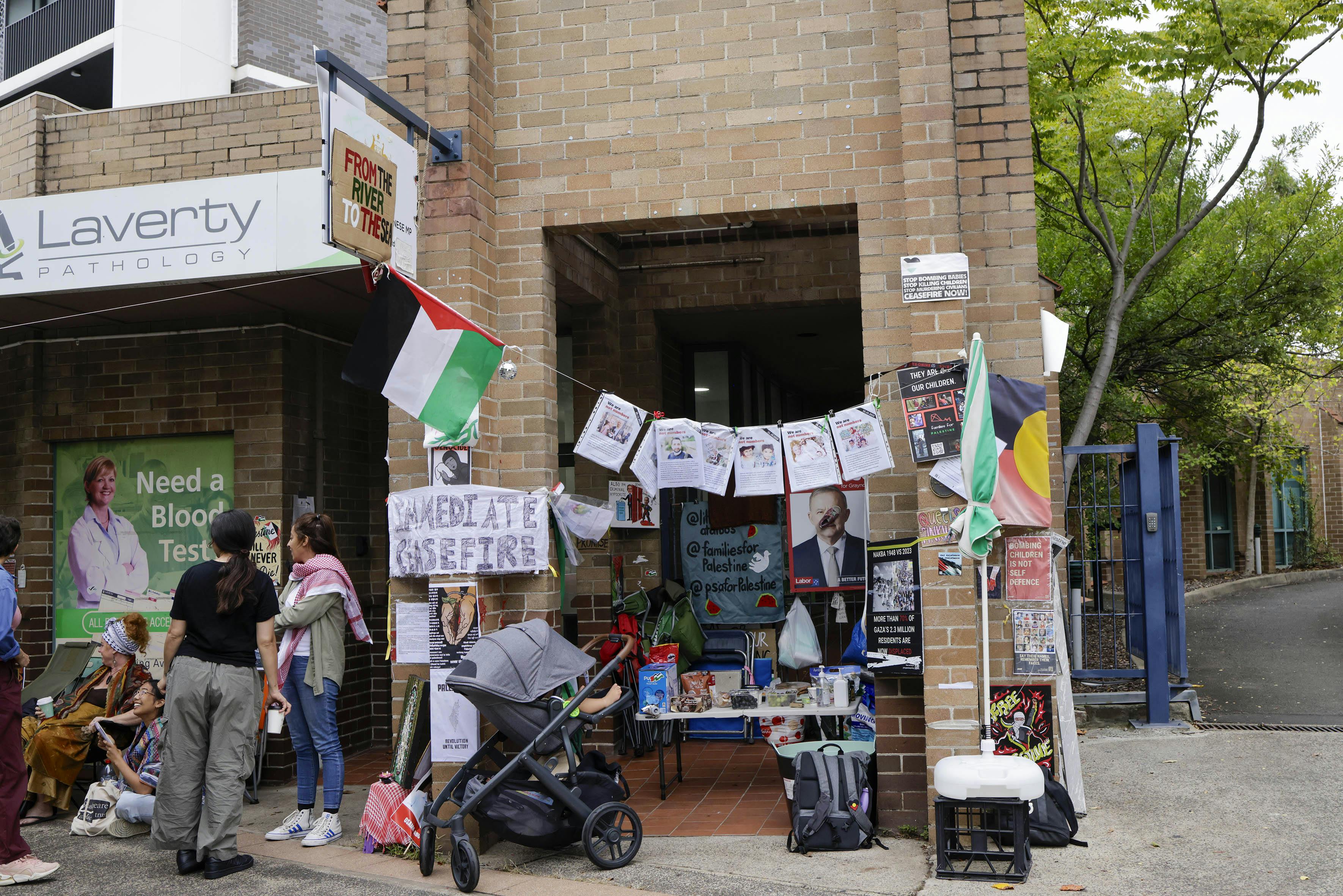
I sit clutching my camera and waiting to pounce if the Prime Minister happens to show up. But there’s no sign of him. Instead, a noisy driver toots a horn and shouts, ‘Free, Free Palestine.’ His passenger waves a Palestinian flag out the window and makes the peace sign with her fingers. I shout, ‘From the river to the sea, Palestine will be free!’ I’m shocked by my extroversion.
There’s lots of chit-chat at the picket. I meet Talitha from Byron Bay, Edward from Hurstville, Tony from Rushcutters Bay, and Lyanne and her eleven-year-old son Louis from Hornsby.
Two beautiful young Arabic men resembling my brothers sit on a steel bench under the shade of a council tree. Fadel introduces me to Aboud and Aiden. Then I meet Zuzia, and Sara. Aboud tells me that Zuzia was the first person to sit. ‘She just showed up one day with her chair and said I’m not leaving until the Prime Minister comes to talk to his constituents.’ She wasn’t alone for long; Sara arrived to sit with her an hour later. Two women. Such radical hope.
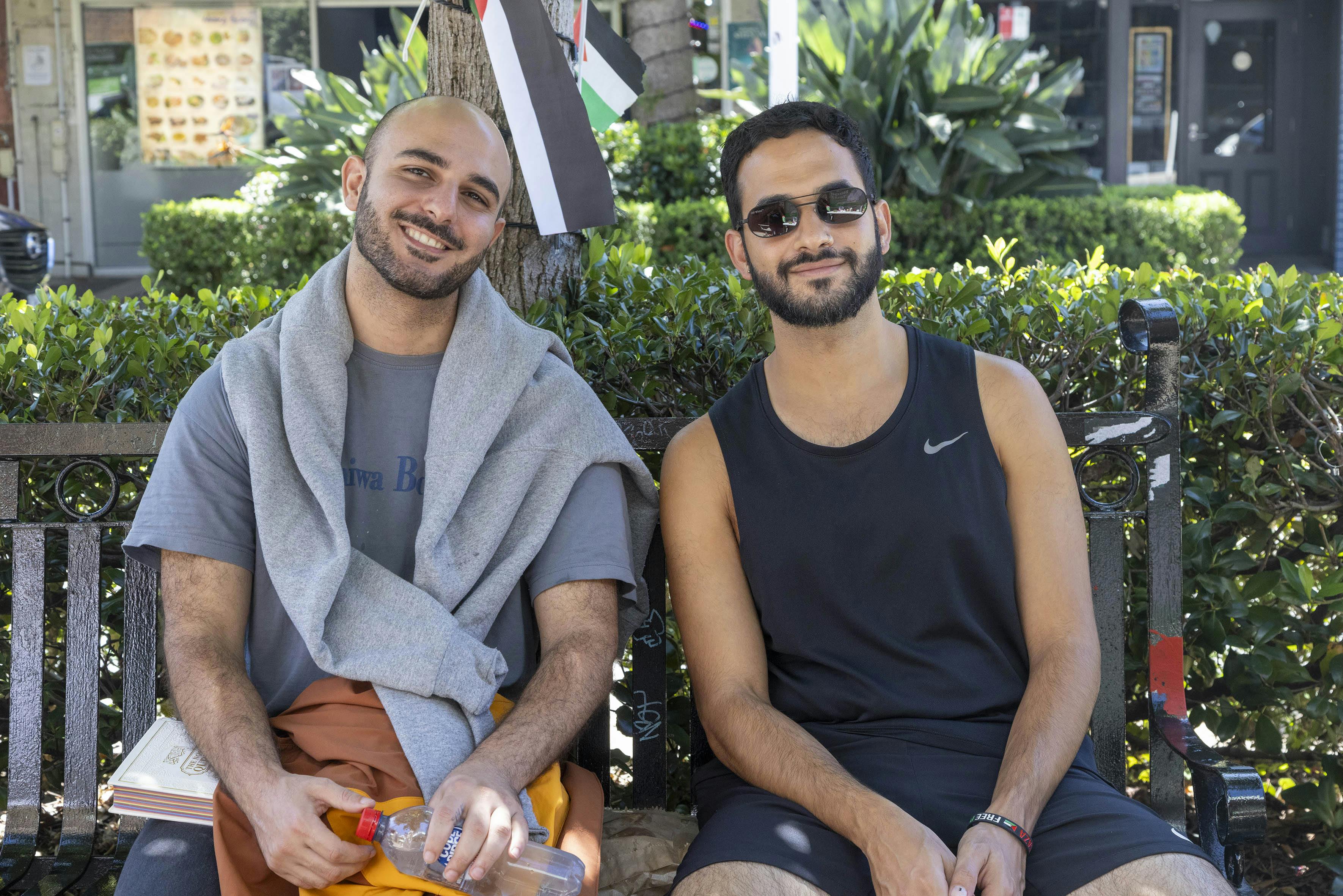
In ‘Notes Toward a Performative Theory of Assembly’, Judith Butler argues that gathering together in physical space is not merely a way for individuals to express grievances or demand change, but a performative act that asserts the rights of bodies to appear in public space, demanding recognition and exercising political agency. Butler examines how this physical presence of bodies in space can challenge and reconfigure the established norms of political life, suggesting that the act of assembly constitutes a form of resistance.
By extension, photographing the sit-in is not merely passive recording of an event, but active participation in the political act of assembly. Click, click, click – the repetitive cadence of the camera’s shutter serves as a protest. The photographic image will travel in time, extending the reach of resistance beyond the immediate time and place of the picket. Photographing helps me recognise the people of the picket as citizens who are geopolitically attached to the precariousness of Palestinians. Outside the Prime Minister’s office, we also confront the reality that our democratic agency is curtailed by government actions (and inaction) that do not represent our desires or interests.
To date, I have taken over fifteen hundred photographs at the picket: the people, the sociality, and the collective creative labour. But still no sign of Albo! I feel disconnected from governmental representation and powerless to influence the genocide’s course. How can my camera soothe our collective grievances?
While manifesting hope and a desire for change, the peaceful sit-in also screams disillusionment. I photograph the signs, stickers, and make-shift banners. Each day, there are new ones. ‘From the river to the sea’, ‘Ceasefire now’, ‘Save Gaza’, ‘Stop bombing babies, stop killing children, stop murdering civilians, ceasefire now’, ‘Boycott Israel’. The DIY placards and repurposed signs demand action from our leaders. Photocopied photographs of dead children are stuck to the brick wall. The faces and names of journalists, doctors and nurses killed hang from the branches of a council tree. Testaments to an ongoing genocide aided and abetted by almost every government on the planet. What have we become?
I photograph the handwritten letters from the picket’s children who have just learnt to write. Their first words a desperate plea to the Prime Minister for action.
I came to the picket thinking I’d stay an hour. I am still here six weeks later, returning daily to ask, Can I take your picture? The answer is mostly ‘Yes!’ I’m a photographer, but not a commercial one. I don’t report from the front line of horrific conflicts and natural disasters. I’m not brave enough for reportage. I don’t have an agent, nor do I sell to Reuters or Getty. Professionally, I describe myself as a photo artist because I have an expensive camera and exhibit my photographs in museums and galleries. But privately, I think of myself as a photographer of everyday life who, like most people, is trigger-happy with a smartphone. Perhaps my peculiar vocation is to make art out of photographing strangers. There are plenty of strangers at the picket. While I photograph them, we talk.
‘I’m Cherine.’
‘I’m Erin.’
‘Do you live in Marrickville, Erin?’
‘No, I live in Chatswood.’
‘You’re amazing. That’s a long way to come.’
‘I’m not amazing; it’s just that I can’t be alone, I’m going crazy, and my friends don’t give a shit about Gaza. At least here, I can talk about it with people who care.’
Then Erin grabs a Palestinian flag and waves it toward the traffic. The passing cars sound their horns in support. Encouraged, she stands up and walks over to the edge of Marrickville Road, where young Louis is already waving a flag. I run to the traffic island to photograph their spontaneous choreography. Two flags are moving in unison. I want a permanent record of their grace.

My attachment to photography began long before the picket. My big Lebanese family can’t stop photographing each other. I have adopted myself to the picket and declare myself a ’photographer in residence’. My project is to capture our enduring togetherness for however long it lasts. But I must confess that I have never done an overnight shift. I can’t say I’ve documented the pickets every hour. I wish I could stay overnight. But my camera is frightened in the evening.
At 6 a.m., the morning air is thick with the night’s residue. My camera witnesses the agonies of a community and the tender public display of dissent. Against the backdrop of genocide photographing the picket feels inadequate; the presence of my camera feels feeble.
I persist.
The picket is the stage where each protester, knowingly or not, performs their role in a drama much larger than themselves, their individual narratives intertwining with collective despair. As the morning unfolds, a group of mothers and babies starts vigil. Three prams are draped in Palestinian flags. The mothers breastfeed, knowing that in Gaza they’d be dead.
From my camping seat, I see the world of the picket anew. The people keep coming: old people, babies, white, brown, black people, all races, religions, genders. People from the Northern Rivers, Sutherland, Homebush, Liverpool, Summer Hill, Campsie, Randwick, Surry Hills, Alexandria, Penshurst, Newcastle, Wollongong, Blue Mountains, Byron Bay, and Tamworth. The picket is a good news story the media doesn’t want to tell.
Photographing the picket is a form of testimony. The images create a visual dialogue transcending social and geographic barriers. We know the colours and textures of protest. We are sitting and screaming inside, waving signs and flags around. We sing ‘tel’has teezee Albanese!’ Like children, we can’t stop laughing, enjoying how the Arabic for ‘lick my arse’ rhymes with Albanese. Despair is compounded by the fact I voted for Albo. Given his past solidarity with Palestine, his current stance and refusal to speak to his constituents is puzzling. I write him a letter to say I will never vote for him or the ALP again. I want to attach some of the pictures from outside his office, but there’s no option to do so on the webpage.
Taped to the steel gate of Albo’s Marrickville office is a red ALP electoral poster for the seat of Grayndler. Someone has glued a child’s pink sneaker to his face. Remember the Iraqi journalist Muntadar al-Zaidi who threw his shoes at President George W. Bush at a press conference in 2008? To have a shoe on your face is the ultimate Arabic insult. The sole of the shoe screams dirt. This is visual activism.
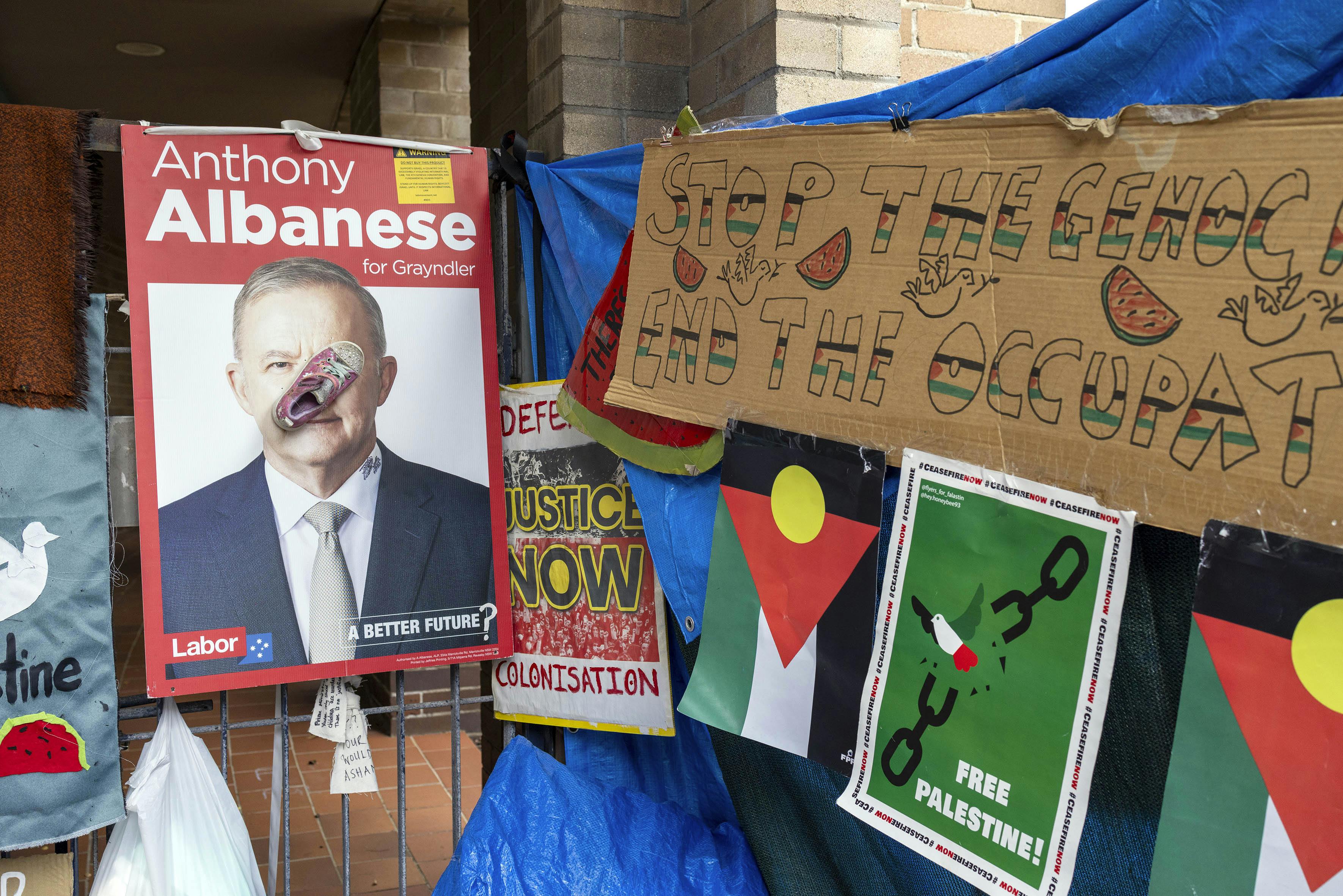
If Katy is sewing under the shade of the tree on Marrickville Road, I know it’s Sunday. I almost fall into her arms; the camera’s weight isn’t helping. I tell her that I’m desperate to feel better. She says, ‘Feeling hopeless in the face of government inaction is debilitating.’ I tell her I can’t listen to the news on the car radio and that I have boycotted the ABC for its treatment of Antoinette Lattouf.
Nish is an incredible listener. I tell her I can’t indulge my friends who want to discuss the latest Hollywood films and the Sydney Biennale. Nish tells me to stop having dinner with people who say, ‘It’s complicated.’ I say, ‘Maybe I need some new friends.’ She says I am already making new friends at the picket.
I am photographing a new friend, Edward. I tell him that since October 7, I haven’t been able to sleep. I tell him that if anyone says ‘It’s complicated’ when talking about Gaza, I’ll explode. Edward says, ‘There is nothing complicated about killing 40,000 people, 13,000 of them children.’ Our conversation trails off as he heads toward the hedge to dig out a flag to wave. Flag waving is our collective mantra. Up, down, left, right. Swish. Swoosh.
‘Can I photograph your yarmulke?’
It’s lunchtime, and a young Jewish person from Wollongong is speaking their pervasive despair and cynicism about the possibility of a ceasefire.
A Jewish woman from the Eastern suburbs is wearing a black and white keffiyeh. She is manic. I hear her refer to her father as a Zionist Nazi. She says that he won’t let her wear a keffiyeh at home. She asked me to photograph her so she could share it on her social media. She wants to make her father angry.
Some people bring books to read, embroidery, knitting, drawing, and laptops to work on; others just want to talk. Can I take a picture of you? A woman from the Blue Mountains tells me she feels abandoned, betrayed, and deeply disillusioned with the political and legal systems that are supposed to protect human rights and uphold justice. I press the shutter button and nod in agreement.
My photographs can’t capture these conversations. Or the sound of Free Palestine being chanted. Or the shrill sirens as the police drive out of Malakoff Street onto Marrickville Road in pursuit of crimes that aren’t genocide.
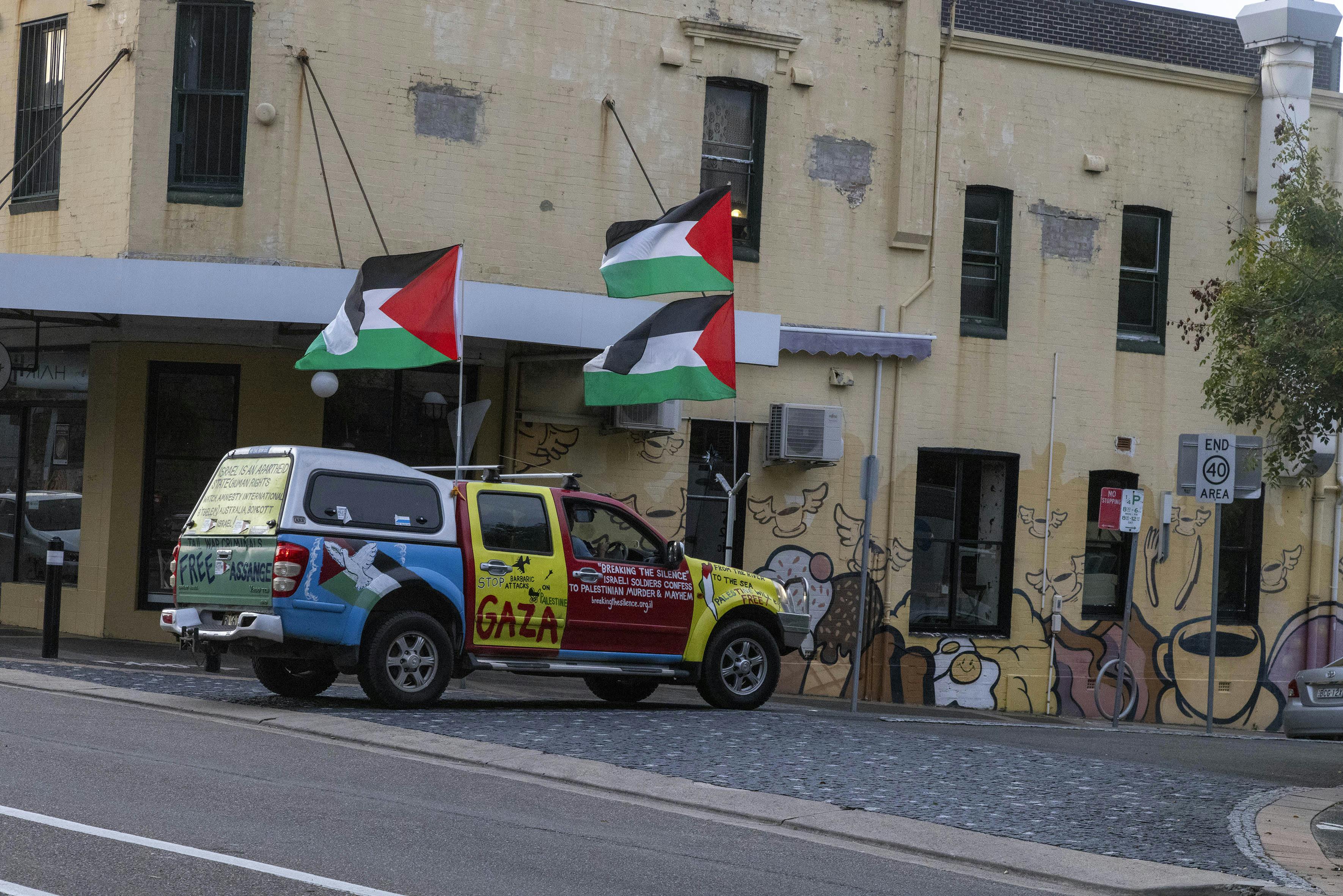
Ramadan has begun. I photograph Iftar at night. There’s a vigil on Thursday night and a die-in on Friday night. ‘Bring your camera, Cherine, please. Everyone will be wearing white and pretending they are dead.’ I’m pleased to be asked.
I photograph Mahreen Faruqi and thank her for speaking out. I’m photographing Aiden with his mother. Then, Sara and her one-year-old son. Ahmed is gearing up to record another video message to Albo. Zuzia is sweeping. The therapeutic need to clean. Keeping the picket in order is Zuzia’s act of love and service.
It gets dark, and I can’t stop photographing the beauty of the queer kids who do the night shift. ‘You messed with the wrong generation!’
On Good Friday, three hundred people line up for food that smells like home. Marrickville Road is transformed into my grandmother’s kitchen.
The little children are playing dress-ups at the entry to Albo’s office. Two young boys are drawing watermelons with chalk on the pavement. Someone has scribbled Free Palestine in Albo’s driveway. A dog lies nearby and scratches itself. I sneak a picture of the cops.
Can I take your picture? An old Greek couple in their seventies tell me about the emotional toll of witnessing the ongoing atrocities without sufficient intervention on Australia and America’s part. I suddenly need the toilet and have to go home.

Photographing the picket transcends mere documentation. In this charged space, photographs are affective artifacts, exercises in empathy and ethics. With each click of the shutter, I am active, doing something in the face of not being able to do anything. Can I turn our collective grief and rage into political expression? Photographing is my intervention, contributing to a communal archive of memory and resistance that demands accountability from the Prime Minister and his government. In the Prime Minister’s absence, I am adding to the archive at a rapid rate. What will I do if he shows up? Will I be skilled enough to get the shot? We hear he has relocated to a secret office in Alexandria. We understand enough about politics to know he will never speak to us. In a way, we’re happy. We have somewhere to go and people to talk to. We are a real community. But we know the ultimate truth: we won’t be here forever. At least we’ll have my photographs.
After twenty-five years of photographing myself and others, I have seen how a camera (in the right hands) can create social opportunities and interactions. Even among strangers. Even in this era of mass surveillance, where distrust of cameras and being watched is pervasive. I have often said that photography helps me meet people. With my camera in hand, being social is easy. I’ve never done anything like this before. The people at the picket are teaching me the depth of protesting. I turned fifty this year. I can’t be on the surface. I don’t do virtue signalling. I must feel the picket to photograph it. I can’t be the fly-in, fly-out photographer reporting a one-off event for ‘work’. I must be part of and inside my photographic subject. I am capturing the picket as a protest and using photography to protest. My photographing needs lived experience.
Photographing can create instant trust between strangers. To build trust between myself and others, I must understand the politics and ethics underlying our social relations. The power dynamics of photographing and being photographed vary depending on who I am photographing. The history of photography is a colonial history, full of misrepresentation and exploitation. I don’t want my camera to hurt anyone. I need to practice what I preach.
In The Civil Contract of Photography, Ariella Azoulay suggests photography can and should act as a form of political engagement and collective witnessing. According to Azoulay, when we take or view a photograph, we enter into a civil agreement that binds us to the realities and horrors pictured. Dismembered bodies; starving and emaciated children; mothers and fathers holding the dead bodies of their babies, their children wrapped in blood-stained white cloth; orphaned newborns crying alone and hungry in hospitals; aid workers running through streets full of human remains; a dog with a human foot in its mouth; a child burnt alive; a man standing on the edge of a crater screaming, his unbearable ungraspable suffering photographed for all the world to see. I am bound as a viewer to act in the face of such horror. How can I attend to my paralysing rage?
The answer arrives through my camera: Can I take your picture? My work is a civil action responding to the photographs and videos from Palestinian journalists and citizens. As Azoulay argues, such records of atrocity are not the endpoint – they prompt action and build an ethical community through a shared social contract. The picket photographs insist that our collective solidarity with Palestinians be seen.
Click, click, cli … my camera’s battery is dead.
Photographing from my seat on the footpath is my form of grieving. Photographing the nurse who carries a placard that asks, ‘Who will care for you when we are dead?’ is affirmative action. With every click of the shutter, I locate my body – the rage, helplessness, and hopelessness – in the image.
Photographing the sit-in is never just photographing. Pointing a camera at this precise moment, at this place and its people, extends beyond capturing visual moments. After six weeks, I am immersed in the daily affective landscape of the sit-in, and I learn that photographing is not just a documentary tool, but a deeply entangled act of participation and protest as well as an interrogation of the possibilities of existence, observation, and connection in what Butler names a world marked by precarity.
When I tell the local Lebanese café owner about the community at the picket and how I am photographing it and making new friends, she doesn’t hear the good news story or revel in my lifeline. Instead, she shouts back at me from the coffee machine. ‘Oh my god, don’t tell me you’re one of those annoying protesters causing traffic jams outside Albo’s office.’ I try to defend myself, but she keeps going. ‘What do you want from him? He can’t fix Israel and Palestine?’ I grab my camera and leave.
Returning to the picket with a coffee in one hand and my camera in the other, I admit to feeling desperate for the warmth of solidarity. Can I take your picture? is my peaceful protest. I’m not committed to a pictorial end or establishing a stylistic signature; I am instead involved in what Butler suggests is an improvised process of assembling. I photograph the people at the picket because I need these people and the solidarity and politics we share. This desire is embedded in every photograph I take. The reassuring comments, the playful hugs, the jokes, the anger and rage, the frustration, boredom, helplessness, despair and laughter all reveal the sociality at the heart of the picket.
In the midst of grief, photographing is affection. At the picket, my camera asks, ‘Can we be friends?’ I share all my photographs with Zuzia and Sara. Two pictures get published in a Crikey article reporting on the picket. But The Guardian and The Conversation don’t want a photo essay of an ongoing peaceful protest outside the Prime Minister’s office. I’m convinced that if things get violent, they’ll change their minds. Photographs are often considered in terms of their aesthetic impact and the photographer’s reputation for creating powerful visual stories. I don’t have that reputation, but I wonder and hope that the famous photojournalist who flew in and out one Friday night will have more luck with the mainstream media. The image itself is often an endpoint, and frequently what is of interest is the subject as social history.
I’m not creating pictures for history. I want you to see them now by attuning to these ongoing actions as social and political processes that extend beyond the representational frame.